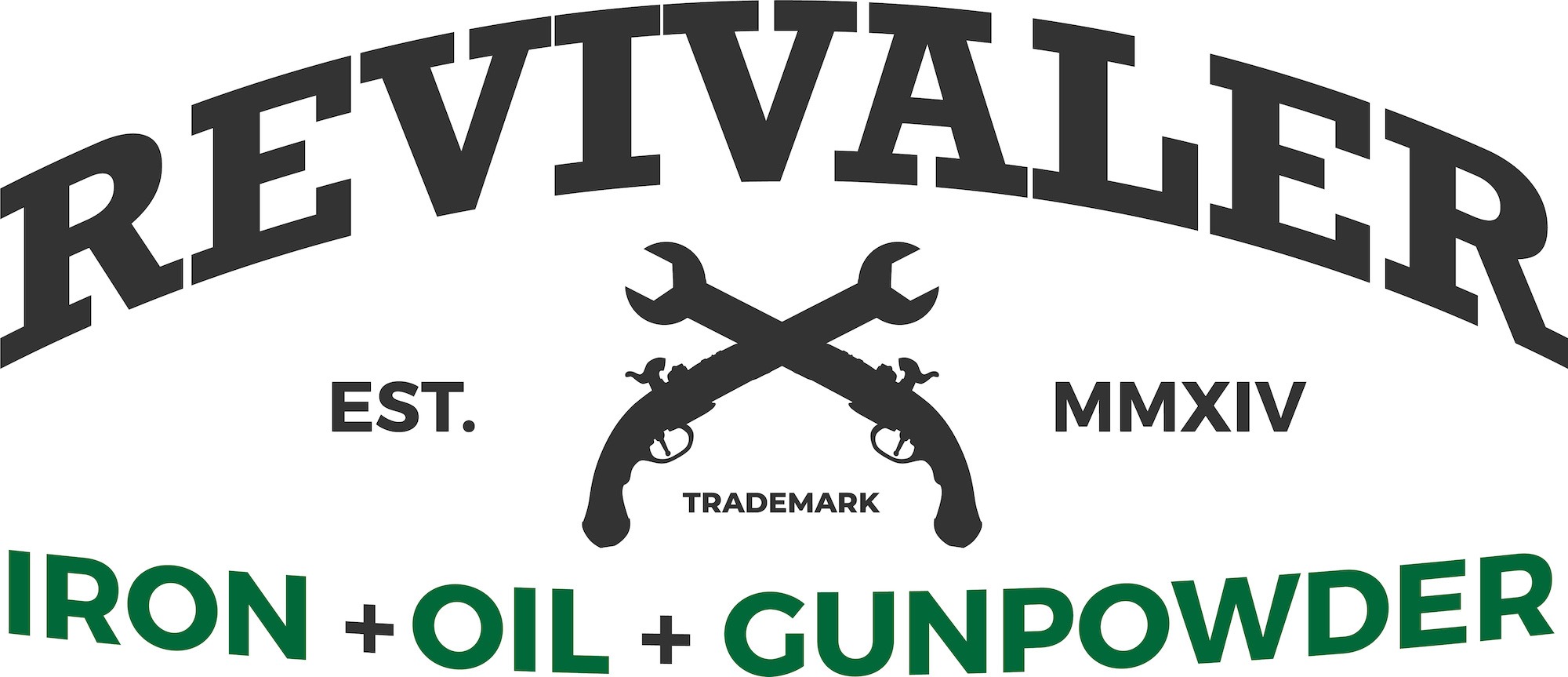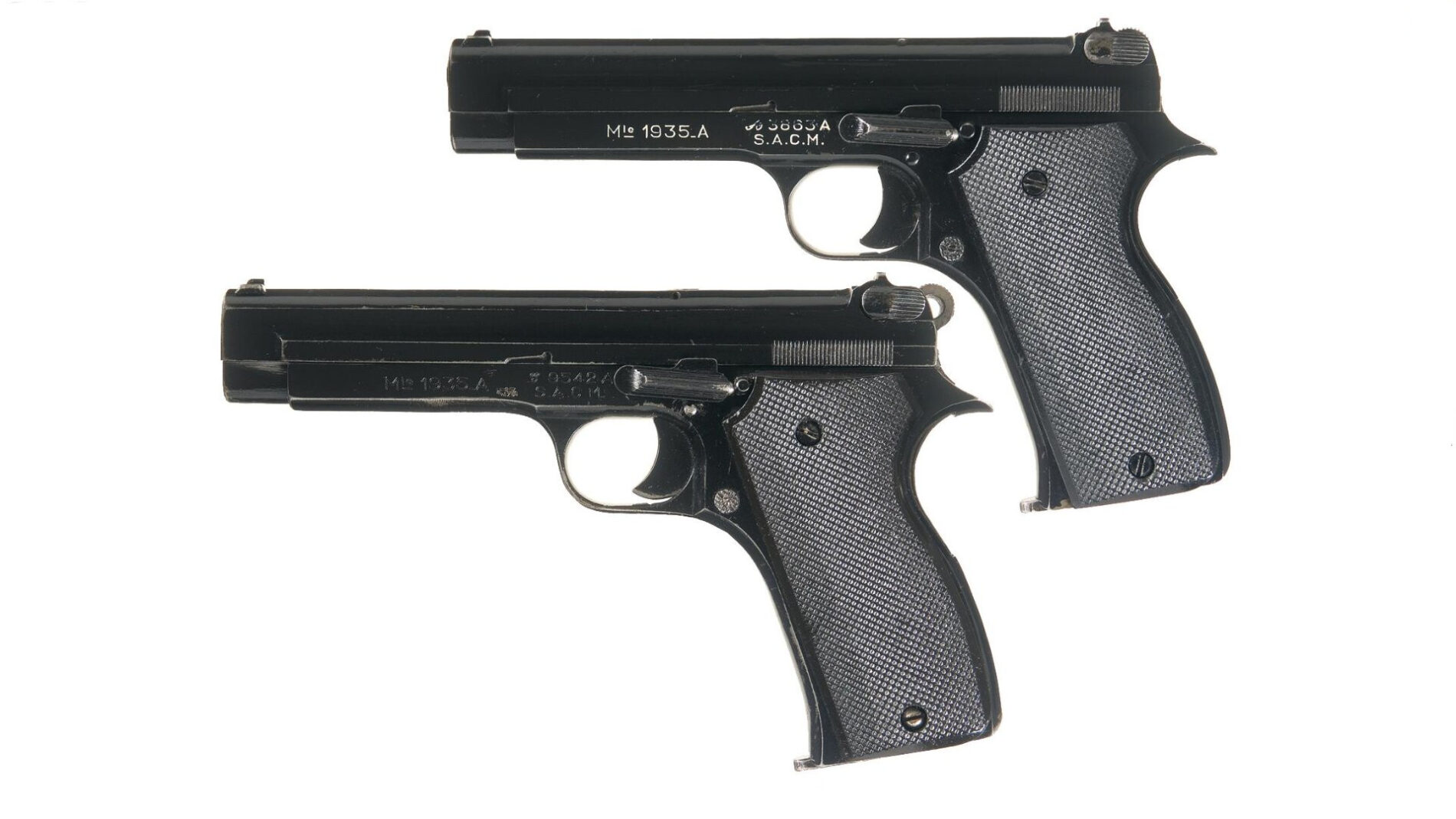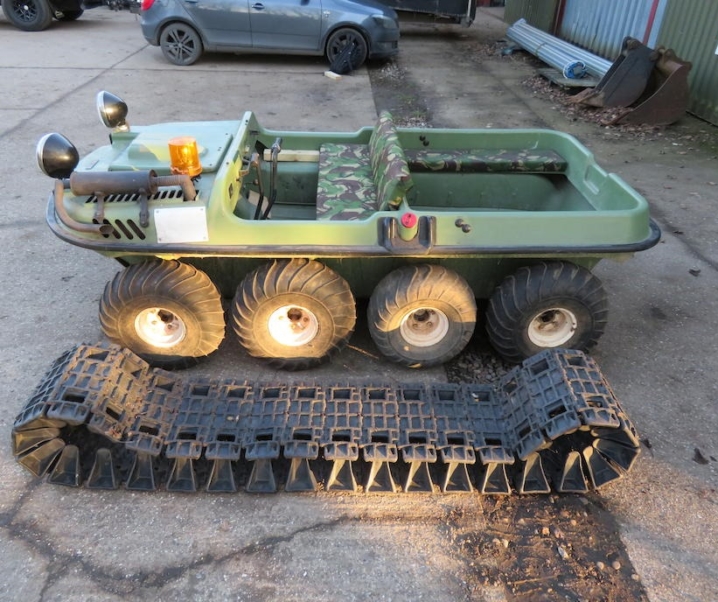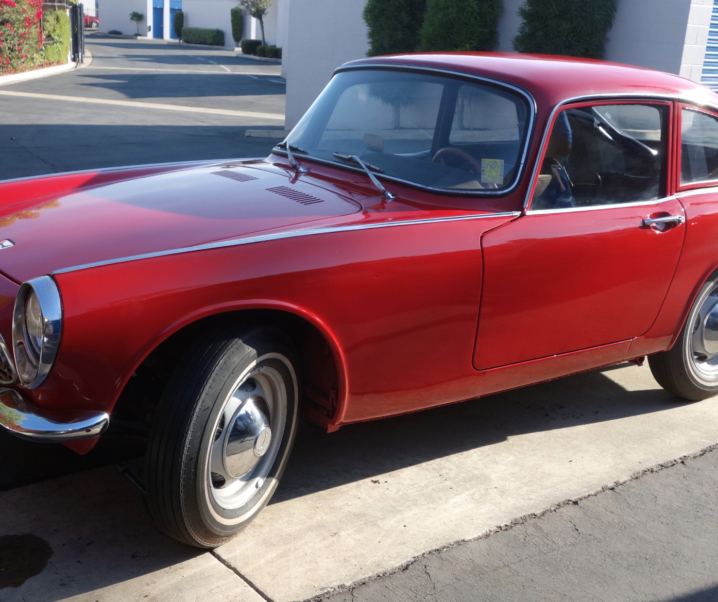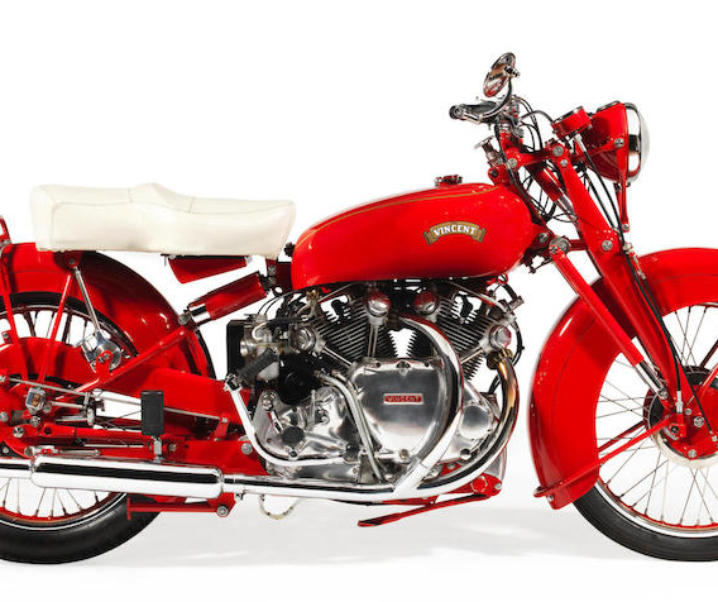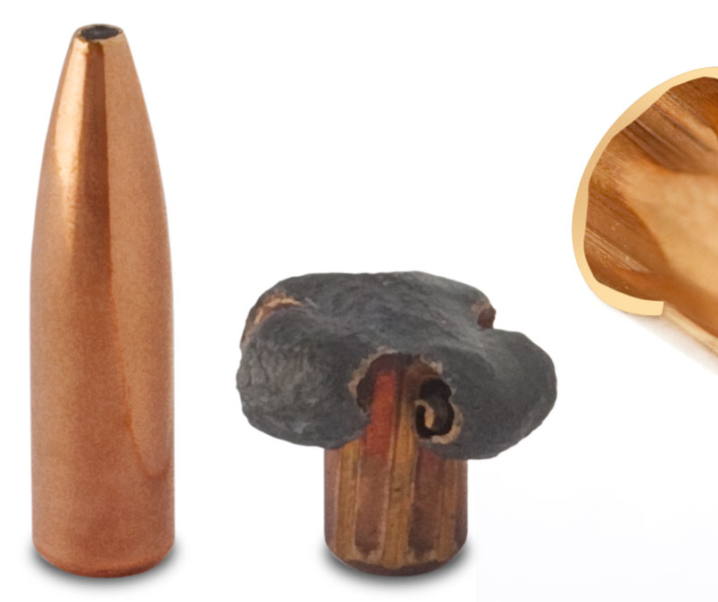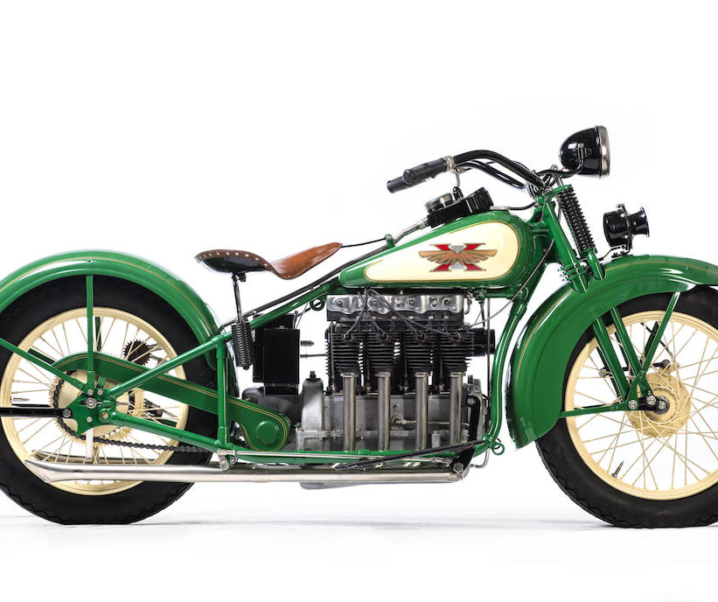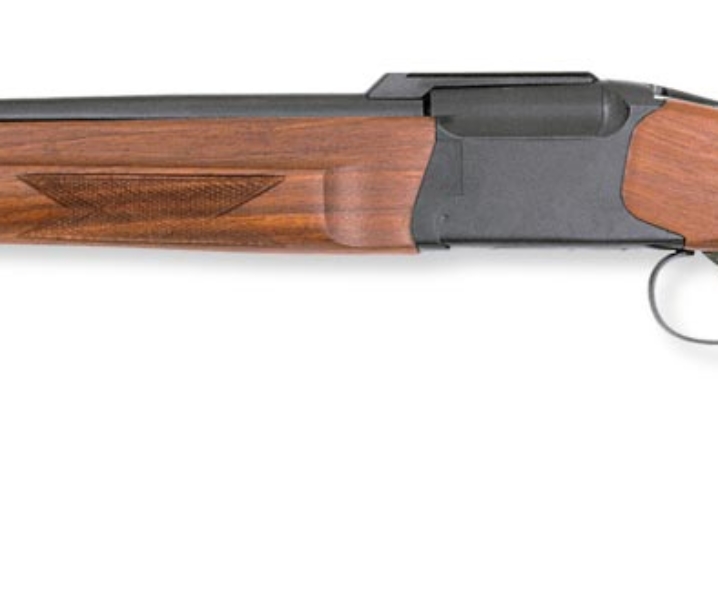The S.A.C.M. Model 1935-A was an excellent pistol designed by an ex French Foreign Legion officer. This rather pretty handgun served on both sides in the Second World War and served France up until the 1960’s.
Fast Facts
- The S.A.C.M. Model 1935-A was created in response to the French military’s request for a new semi-automatic pistol to replace their obsolete revolvers.
- The French military required this new pistol to meet certain set criteria and these are evident in the design of the Model 1935-A.
- The Model 1935-A was made in 1935, accepted for military use in 1937, with delivery of pistols happening in late 1939.
- Production of the Model 1935-A ended in 1956.
The first time I encountered an S.A.C.M. Model 1935-A two things immediately struck me; the first was that it looked very like the Swiss SIG P210, and the second was that it looked like someone had covered it in black paint.
I must confess that the fact that this rather pretty pistol had been painted absolutely horrified me. All the handguns I’d owned had been nicely blued so in my thinking slapping a coat of black paint on a pistol was a sin so dreadful that I would have punished the perpetrator by making them write out a thousand times “I must not paint pistols”.
It was only as I began to learn the history of the French Model 1935-A that I understood the reason for the coating of black baked enamel. This was a pistol, not made for commercial sale, but made for war, and when the pistol was made that war was at France’s doorstep, the threat was immediate, and France needed guns in a hurry.
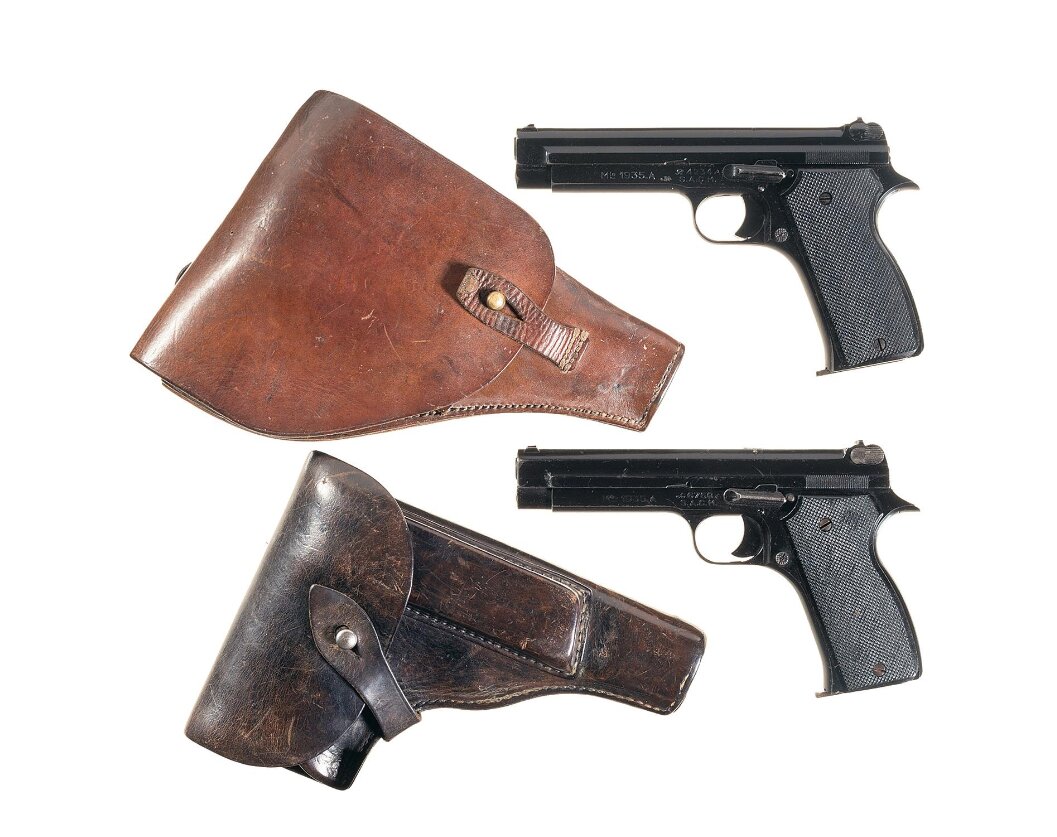
Despite the Model 1935-A being made as a pistol for the upcoming war against the Nazis it was a beautiful design, beautifully made. I think that the French cannot help themselves but to make things beautiful, it seems to be in their national soul. It has been the French who gave the world the Bugatti automobiles and high-speed railcars of the 1920’s and 1930’s: the wonderful Avions Voisin: and their railway steam locomotives such as those by André Chapelon were among the most outstanding the world has ever seen both from an aesthetic and engineering standpoint.
France’s previous experience of war had been The Great War (i.e. World War I) which was fought in the mud and rain in brutal trench warfare – so a pistol that was Parkerized and then covered in baked enamel would be a sensible thing to gain the durability to survive that kind of use.
The prior French military handgun, as used by French officers during World War I, was the Model 1892 which is also known as the Lebel revolver and also as the St. Etienne 8mm. The experience of using revolvers in the trenches was not particularly satisfactory and this persuaded the French military to make the move to a semi-automatic pistol after the war ended.
But as is often the case, the government took their time in making this move and it was not until 1935 that the process of calling for designs and prototypes for testing was really begun. And it was not until 1937 that the choice was made – far too late to be able to equip the military with the sheer numbers of pistols that they were going to need.
There were two main contenders for the military contract – the Model 1935-A, which was designed and made by S.A.C.M. (Société Alsacienne de Constructions Mécaniques – i.e. the Alsace Mechanical Manufacturing Company): and the Model 1935-S, which was designed and made by M.A.S. (Manufacture Nationale d’Armes de Saint Ètienne – i.e. the National Arms Manufacturer of Saint Ètienne).
The Model 1935-A was the winner of the contract in 1937, but with the spectre of Nazi jackboots threatening to cross the border into France sometime very soon both the Model 1935-A and the Model 1935-S were put into production.

The French realized that was not going to be enough and so other makers were encouraged to make and supply pistols for the French military. Notable among these was MAPF (Manufacture d’ Armes des Pyrénées Françaises) who supplied their Unique Model 17 in significant quantities.
The standard military cartridge specified for the Model 1935-A and 1935-S was the 7.65x20mm Long: which fired a 5 gram (77 grain) steel jacketed bullet at 345 meters/second (1,132 fps) delivering muzzle energy of 297 Joules (219 ft/lb). This ammunition being loaded in steel cartridge cases.
This is of course not a particularly powerful cartridge but it seems the military were happy with it: recoil would be fairly mild, and the enemies of France would be “lightly killed”.
The Unique Model 17 was chambered for the 7.65x17mm (32 ACP) as were the Italian Navy pistols the Beretta Model 1935.
The S.A.C.M. Model 1935-A was designed by an ex Foreign Legion Captain named Charles Petter: a man who had solid military training and experience, and a man who had well developed knowledge and skills in military firearms design. Petter was a director at S.A.C.M.
His design for the Model 1935-A was in part based on John Moses Browning’s M1911, but with subtle improvements. Despite the 7.65x20mm cartridge being relatively low powered Petter opted for a locked breech recoil operated action. This may have been intended to reduce recoil and improve reliability.
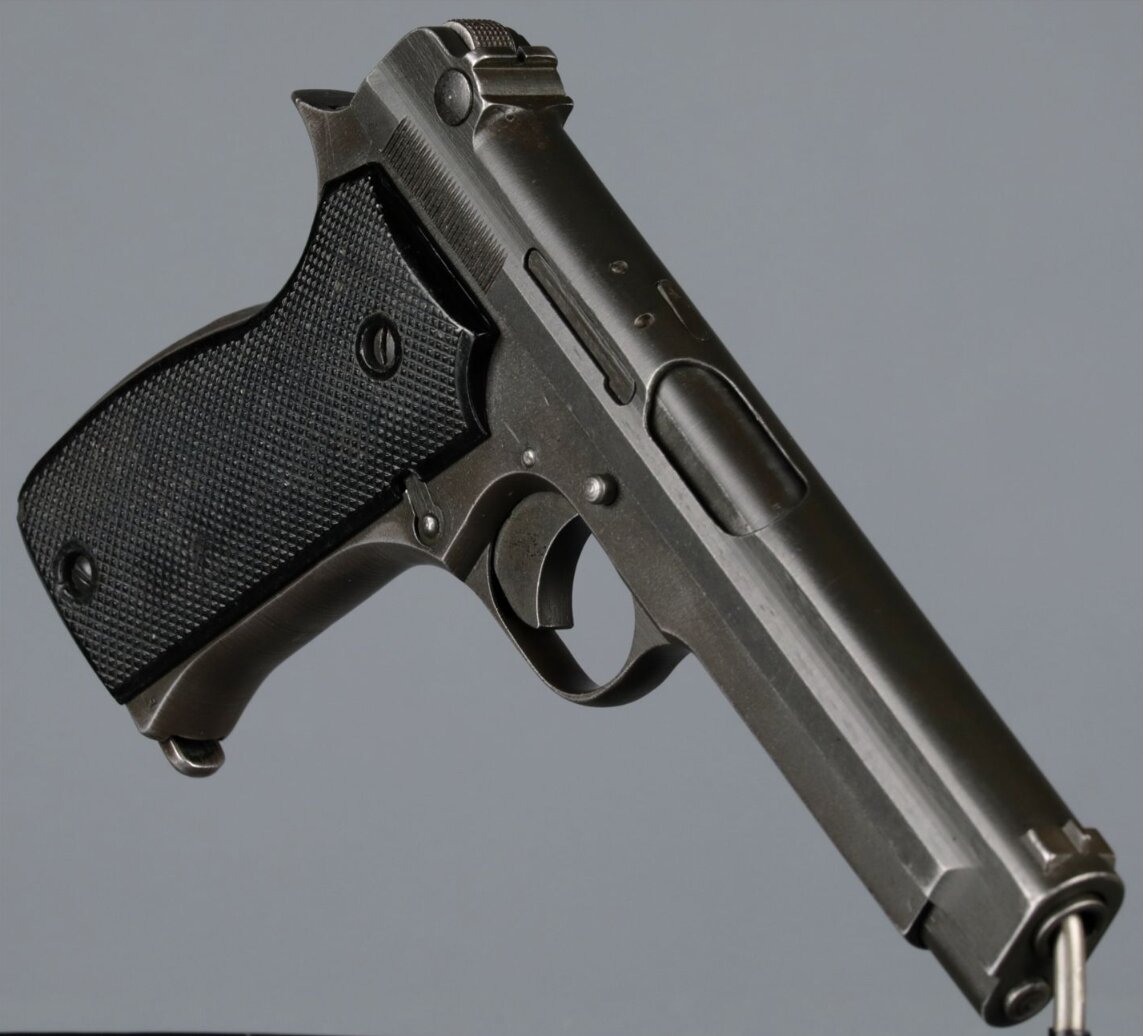
Petter eliminated Browning’s barrel bushing and instead used a full length recoil spring with guide rod. Instead of a single swinging link under the barrel Petter used two. The recoil stop passed through both links and a drilled hole in the guide rod.
The locking of the barrel and slide was just like the Browning design with two locking lugs on the top of the barrel that lock into corresponding lug recesses in the slide.
The French military had specified for the trial pistols that they would feature a unitized hammer, sear and mainspring assembly that used a single spring for the hammer and sear and which could be removed and replaced in the field, and so this feature was built into the Model 1935-A.
The safety catch of the Model 1935-A was a product of the French military’s specifications. It was a hammer safety which was located on the left rear of the slide. It had to be rotated through 90 degrees to stand upright next to the rear sight when on safe. So it provided a significant warning both visual and tactile that the pistol was on safe.
When on safe the safety placed a barrier over the firing pin so the hammer could not contact the firing pin. So, on safe, it was safe to lower the hammer with a live round in the chamber, something it is not advisable to do with a M1911.
The pistol was equipped with a magazine safety, and that magazine was single column and held eight rounds. The pistol was also fitted with a loaded chamber indicator which is visible on the top left of the slide. The magazine release was at the rear of the trigger guard just like on the M1911.
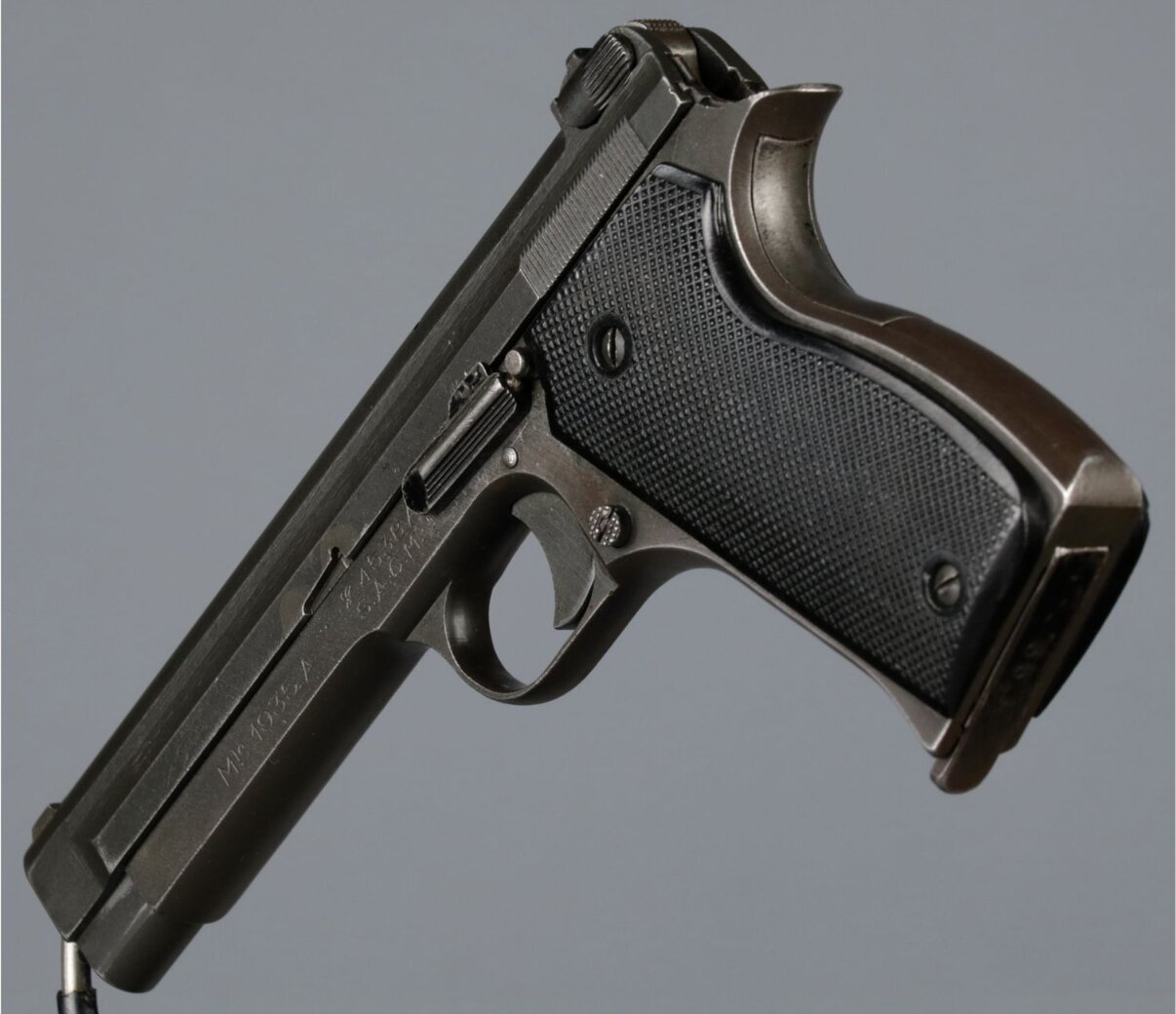
In 1937 as the nations of Europe geared up for the war they hoped would not come – but which looked pretty certain – the Swiss looked favorably on Charles Petter’s design and purchased a license to manufacture the pistols. That was to become the Swiss SP47/8 which would later be known as the SIG P210.
SIG really perfected the Petter design. They changed the slide so that instead of it running in rails outside the frame into grooves in the slide they did the reverse – so the rails were inside the frame and grooves outside the slide. This provided better support and created a pistol with rather better accuracy.
The SIG P210 benefited from Swiss quality control and engineering and came to be regarded by many, including myself, as the best semi-automatic pistol ever made. Most were made in 9mm Parabellum and they were a delight to shoot.
S.A.C.M. were able to begin deliveries of the Model 1935-A pistols to the French military in the latter part of 1939, even as the war in Europe began. They managed to deliver about 10,700 pistols before the Nazi invasion.
With the Nazis in control S.A.C.M. continued production and the pistol was designated Pistole 625 (f) by the Nazis. From 1940 until the Nazi withdrawal in 1944 about 23,850 Model 1935-A pistols were made for Nazi controlled forces.
Once the Nazis were expelled from France S.A.C.M. were able to make another 50,400 Model 1935-A pistols up until February of 1956. In total 84,950 pistols were made.
Despite the large number of these pistols that were made they were not much sold on the surplus market, and many would have been casualties of the war. This scarcity is also no doubt caused by the lack of 7.65x20mm Long ammunition.
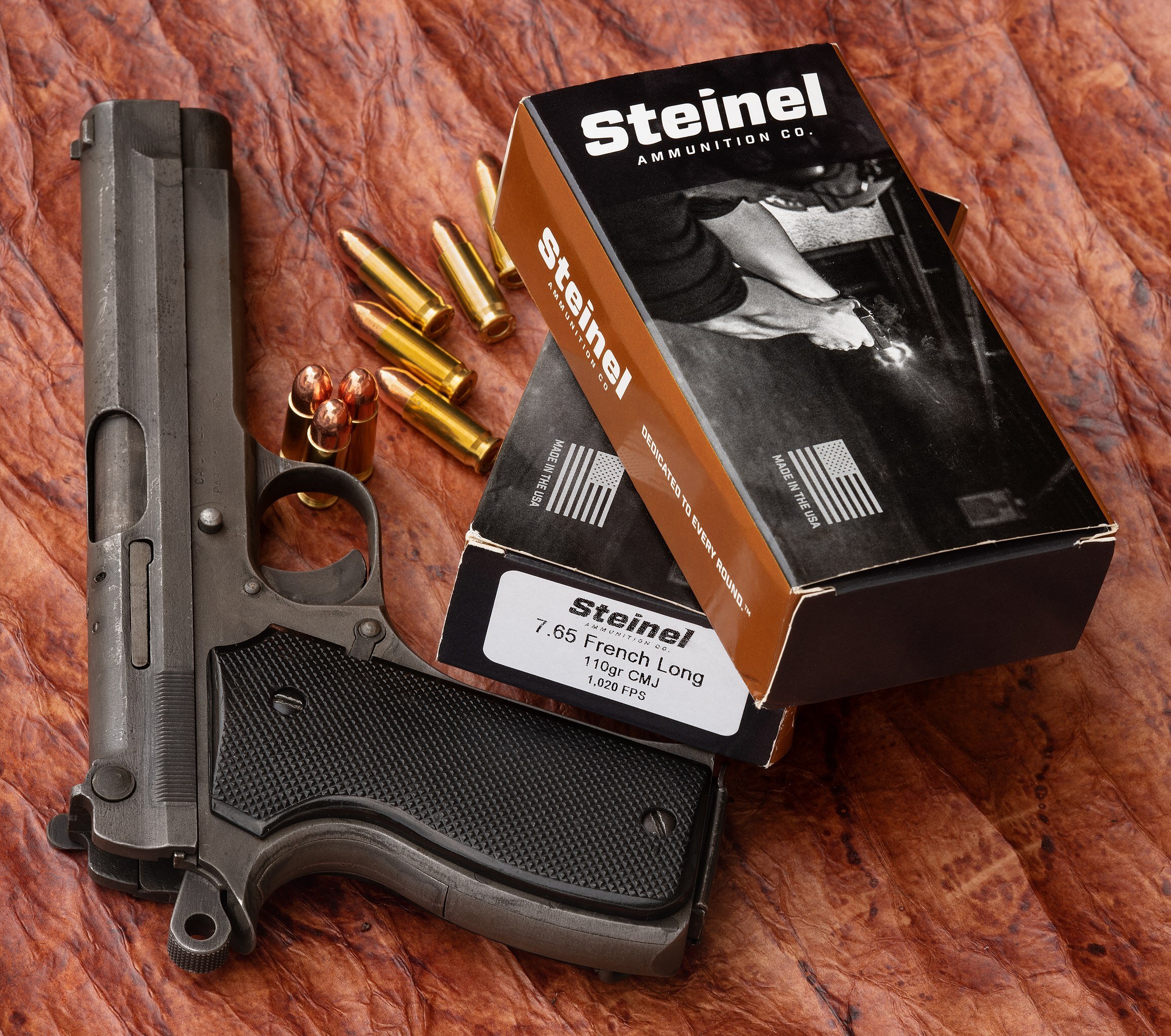
Steinel Ammunition began making 7.65x20mm Long ammunition in 2019 so ammo should be obtainable. For reloaders the ammo can be made either using fired Steinel cases or if you have a small lathe and the skills to drive it by modifying 32 Smith & Wesson Long cases by turning the rim off and creating a suitable extractor groove with new correct size rim.
The S.A.C.M. Model 1935-A not only served in the Second World War – on both sides – but also in France’s post-war colonial wars in Vietnam, Laos, Cambodia, and Algeria. It was in active use up until the 1960’s.
These are a pretty handgun and they handle beautifully. They were not perfect but the Model 1935-A served well and proved to be a great foundation on which the Swiss built their SIG P210.
Specifications
Length: 7.75 inches (197 mm)
Height: 4.96 inches (126 mm)
Barrel Length: 4.29 inches (109 mm)
Weight: 1.61 lb (730 grams)
Picture Credits: Feature image at the head of this post courtesy Rock Island Auction. Other pictures as individually credited.
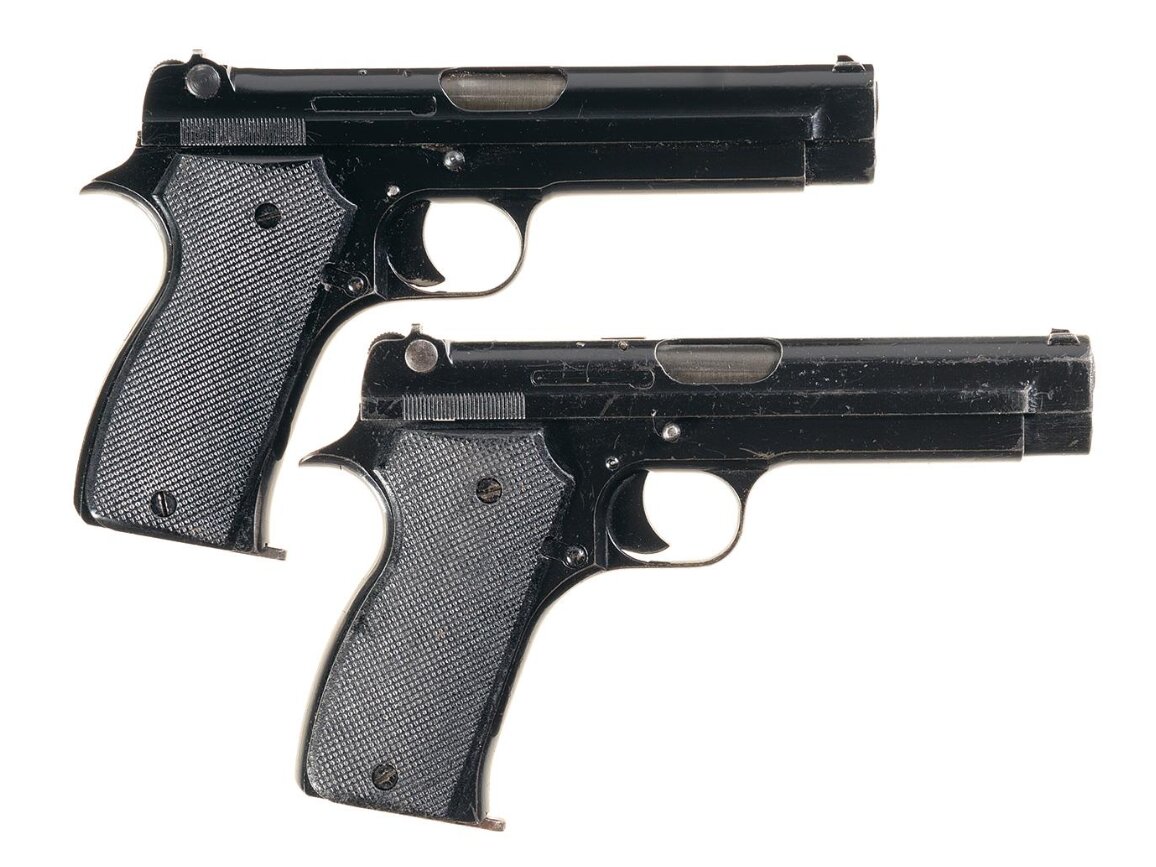
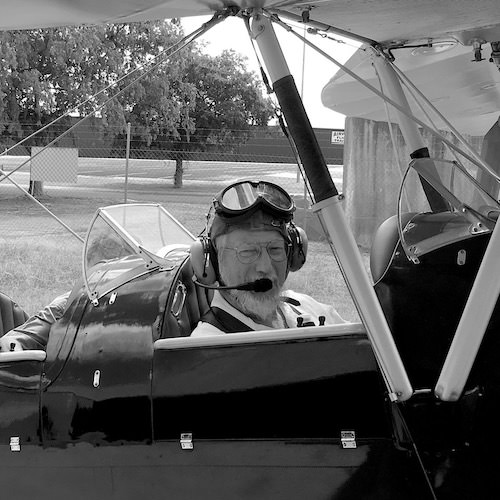
Jon Branch is the founder and senior editor of Revivaler and has written a significant number of articles for various publications including official Buying Guides for eBay, classic car articles for Hagerty, magazine articles for both the Australian Shooters Journal and the Australian Shooter, and he’s a long time contributor to Silodrome.
Jon has done radio, television, magazine and newspaper interviews on various issues, and has traveled extensively, having lived in Britain, Australia, China and Hong Kong. His travels have taken him to Indonesia, Israel, Italy, Japan and a number of other countries. He has studied the Japanese sword arts and has a long history of involvement in the shooting sports, which has included authoring submissions to government on various firearms related issues and assisting in the design and establishment of shooting ranges.
